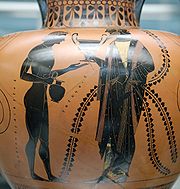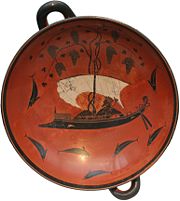
Exekias
Encyclopedia

Pottery of Ancient Greece
As the result of its relative durability, pottery is a large part of the archaeological record of Ancient Greece, and because there is so much of it it has exerted a disproportionately large influence on our understanding of Greek society...
, who worked between approximately 550 BC - 525 BC at Athens
Athens
Athens , is the capital and largest city of Greece. Athens dominates the Attica region and is one of the world's oldest cities, as its recorded history spans around 3,400 years. Classical Athens was a powerful city-state...
. Most of his vases, however, were exported to other regions of the Mediterranean, such as Etruria
Etruria
Etruria—usually referred to in Greek and Latin source texts as Tyrrhenia—was a region of Central Italy, an area that covered part of what now are Tuscany, Latium, Emilia-Romagna, and Umbria. A particularly noteworthy work dealing with Etruscan locations is D. H...
, while some of his other works remained in Athens. Exekias worked mainly with a technique called black-figure
Black-figure pottery
Black-figure pottery painting, also known as the black-figure style or black-figure ceramic is one of the most modern styles for adorning antique Greek vases. It was especially common between the 7th and 5th centuries BC, although there are specimens dating as late as the 2nd century BC...
. This technique involves figures and ornaments painted in black silhouette (using clay slip) with details added by linear incisions and the occasional use of red and white paint before firing. Exekias is considered the most original and most detail-orientated painter and potter using the black-figure technique. The vase-painter Andokides
Andokides
Andokides was a famous potter of Ancient Greece. The painter of his pots was an anonymous artist, the Andokides painter, who is recognized as the creater of the red-figure style, beginning around 530 BC. His work is compared with Exekias, who was said to have created the most detailed and best...
is thought to be a student of his.
Background

- "the hallmark of his style is a near statuesque dignity which brings vase painting for the first time close to claiming a place as a major art" (John Boardman, Athenian Black Figure Vases, 1974).
He was an innovative painter and potter, experimenting with new shapes and devising unusual techniques such as a coral-red slip to enhance colour.
Sixteen signed works by Exekias have survived, while many more have been attributed to him by stylistic comparison. His signed pieces provide important insight not only into the work of Exekias himself but also into the way ancient pottery workshops operated. Twelve of the fourteen vessels bearing his name refer to him not as their decorator but as their potter, by adding the word epoiesen to his name. This translates into "Exekias made me" in contrast to egrapsen, which would translate into "decorated me". In two cases (Berlin Antikensammlung 1720 and Vatican Museo Gregoriano Etrusco 16757) the iambic trimeter "Exekias egrapse kapoiese me" (Exekias made and decorated me) was added, suggesting that in these two cases Exekias was responsible for both the making of the vase and its decoration. This fact, of course, leads to the question whether those vessels signed by Exekias "the potter" were decorated by someone else or whether he only chose to sign work he was proud of. Seven of the vessels signed with "Exekias epoiesen" carry too little decoration to compare. Only two vases show decoration similar in style to those two signed with "egrapse kapiese me" while the others can probably attributed to the so called Group E, to which Exekias is closely related.
While Exekias's work itself offers a glimpse the culture of ancient pottery, their places of excavation also reveal information about the market in which Exekias positioned himself. For example, many of his pieces have been found in the agora of Athens, the center of the Hellenic world; this suggests that Exekias maintained a clientele in the country that he worked. Pieces attributed to Exekias have also been excavated from the Acropolis, which underscores his prestige as a vase painter. Since the Acropolis functioned as place for religious ceremony, the fact that any of his work would be displayed there demonstrates that Exekias was revered as a painter.
Just as he enjoyed a viable market throughout Greece, Exekias also catered to the Italian economy, namely the Etruscans. Aside from Athens, Greece, many of Exekias's other pieces have been found in Etruria, Vulci or Orvieto. Admirers of the Hellenic people, the Etruscans seem to have imported Greek vases. Since Exekias's work has been found in Etruria, it suggests that foreign people also admired his work, so he was able to sell his pieces overseas. In this sense, Exekias maintained a dual economy- one local and one abroad.
Group E
The work of Group E is not only considered to be closely related to the work of Exekias but also represents a conscious break from the pottery traditions of the first half of the sixth century BC. The development of new, elegant vessel shapes such as the "Type A Amphora" have been attributed to this group. Exekias worked as a potter in the Group E-workshop and is the only member of the Group signing his products (Paris Louvre F 35). His potter signatures suggest that Exekias may have been responsible for the development of such vessel shapes such as the Type A cup, the Type A belly amphora and the calyx crater. Apart from the specialization in certain vessel shapes, the Group E also shared a common range of subjects. The birth of Athena, Theseus fighting the MinotaurMinotaur
In Greek mythology, the Minotaur , as the Greeks imagined him, was a creature with the head of a bull on the body of a man or, as described by Roman poet Ovid, "part man and part bull"...
, Herakles fighting the Nemean Lion and Herakles and the three-bodied Geryon are among the themes most often pictured on the vases of this group.
Vessel shapes
Exekias doesn't seem to have been specialized in a specific vessel type. Among the vases made or decorated by him are belly amphorae, Type A cups, calyx craters, Little master cups, Siana cups, dinoi, pyxides and a Panathenaic amphora. Probably his most unusual works is represented in two series of funerary plaques found in Athens (Berlin Antikensammlung 1811, 1814). The plaques, showing the funerary ritual for a deceased man, were probably attached to the walls of a funerary monument, either in- or outside.Themes

One of his most famous works is the so called Dionysos cup (Munich, Antikensammlung 2044). The cup falls into the category of eye cups and is decorated on the outside with two pairs of eyes. Unlike other examples of this group, figuratice scenes are filling the space at the handles, probably an innovation by Exekias. The interior shows a depiction of the god Dionysos on top of a coral-red slip, which coated the entire picture-space. The Dionysos kylix uses the bottom of a wine bowl as a working surface for the main scenario. Dionysos was the god of inspiration. The painting depicts the initial journey of Dionysos to Athens by ship. Pirates had seized the ship and were going, perhaps, to sell Dionysos into slavery. Instead the god caused vines to grow from the mast, frightening the pirates so much that they jumped overboard and were changed into dolphins.
Another re-interpretation of the mythological past can be seen on an amphora in the Vatican (344). It shows Achilleus and Ajax, both identified by their names added in genitive. They are sitting across from each other, looking at a block situated between them. The game, which might be compared to modern backgammon, was played with dice. According to the words written next to the two players Achilleus has thrown a four while Ajax threw a three. Although the two of them are pictured playing a game, they are clearly depicted as being on duty, wearing their body-armour and both holding a spear. The rest of their weapons are situated in close proximity, suggesting that they might head back into battle any moment. Apart from the selection of this very intimate scene as a symbol for Trojan war, this vase-painting also shows the talent of Exekias as an artist. The figures of both Archilleus and Ajax are decorated with fine incised details, showing almost every hair.
The only kalos-name used on vases attributed to or signed by Exekias as a painter is Onetorides, while "Stesias kalos" appears on two amphorae he signed as a potter, but which were painted by a painter of Group E.
Composition
In addition to the main tableau are subordinate ones. Where there are no tableaux, he uses rows of rosettes, spikes, spirals and plain bands. Sometimes he surrounds the main tableau with simple black, so that it appears suddenly, out of the darkness, so to speak.It is diagnostic of Exekias that he uses the shape of the vessel and its protrusions as a terrain to which the lines and forms of the painting conform. As you gaze directly at the tableau, a center of attention appears: the game board, the face of Penthesilea, the starry robe of Dionysos, the sword implanted in the earth. In the round surface of the vase, this point is closest to the eye and is seen directly on.
All the other main lines are either concentric around the thematic center or lead to it as the spokes of a wheel: the spears of the warriors, the curved backs of their hunching forms, the wind-filled sails of the ship and its curved bottom, the circle of dolphins, etc.

